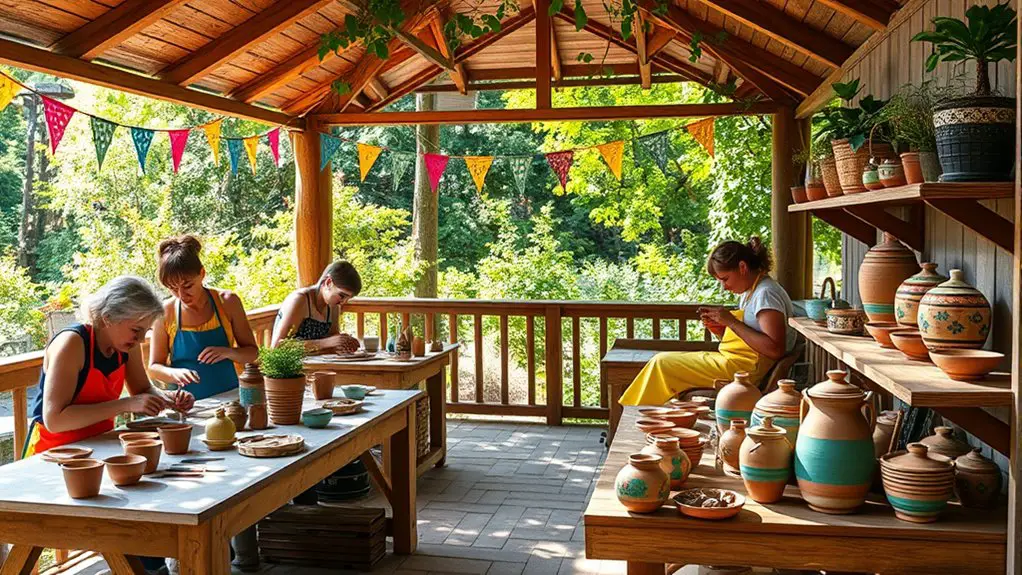To organize a pottery or clay sculpting workshop in your gazebo, choose a serene location with good natural light and a comfortable layout. Select suitable clay types and essential tools, ensuring they’re easy to use for various skill levels. Plan the workshop’s timeline, including hands-on demonstrations and breaks for socializing. Promote your event through social media and local partnerships. Finally, create a fun atmosphere with music and icebreakers, all while emphasizing creative expression. Discover more tips to take your workshop to the next level!
Choosing the Right Location and Setting Up Your Gazebo
When you’re planning a pottery workshop, selecting the right location for your gazebo can make all the difference in creating an inviting atmosphere. Consider a spot that offers a tranquil outdoor ambiance, where natural light filters through the trees. Your gazebo layout should prioritize accessibility and comfort, allowing participants to move freely while working on their creations. Arrange tables in a circular formation to encourage collaboration and connection among attendees. Don’t forget to incorporate elements like plants or soft lighting that enhance the space without overwhelming it. A well-thought-out setting not only fosters creativity but also provides a sense of freedom, letting everyone express themselves through their art while enjoying the beauty of nature. Additionally, ensure that the gazebo is placed on flat, sturdy ground to provide stability and comfort for all participants.
Selecting Materials and Tools for Your Workshop
As you commence on organizing your pottery workshop, selecting the right materials and tools is essential to ensuring a smooth and enjoyable experience for all participants. Start by choosing the appropriate clay types—earthenware, stoneware, or porcelain—based on your group’s skill level and project goals. Each clay type offers unique textures and firing requirements, so consider what your participants will enjoy most.
Next, focus on tool selection. Basic tools like clay knives, rolling pins, and sculpting tools are crucial. Don’t forget to include sponges, water buckets, and aprons for a mess-free experience. A well-organized workspace with all necessary materials will empower your participants to express their creativity freely and confidently, making your workshop a memorable occasion.
Planning the Workshop Structure and Activities
Structuring your pottery workshop effectively can make all the difference in participants’ engagement and learning. Start by creating a clear workshop timeline that outlines each segment, ensuring everyone knows what to expect. Consider incorporating activity rotation to keep the energy flowing; this allows participants to explore various techniques without feeling stagnant.
For example, you might begin with a brief introduction, followed by a hands-on demonstration, then split into smaller groups for individual projects. Schedule regular breaks to encourage conversation and creativity among participants. Flexibility is key—be prepared to adjust based on the group’s dynamics. Ultimately, your goal is to foster a relaxed environment where creativity thrives, letting attendees express themselves freely while mastering their pottery skills.
Promoting Your Workshop and Attracting Participants
How can you effectively promote your pottery workshop and draw in participants? Start by leveraging social media platforms like Instagram and Facebook to showcase your creative space and share vibrant images of pottery. Post engaging content that highlights the experience participants will enjoy. Consider forming local partnerships with art supply stores or community centers; they can help spread the word and might even offer exclusive discounts for their customers. Hosting a free introductory session can also attract interest—people love free experiences! Don’t forget to create eye-catching flyers to place around town. Encourage word-of-mouth by inviting past participants to share their experiences. With these strategies, you’ll create a buzz and bring in those enthusiastic to release their creativity in your gazebo!
Tips for Ensuring a Fun and Engaging Experience
Once you’ve successfully attracted participants to your pottery workshop, the next step is to create an environment where everyone feels welcome and inspired. Set the tone by arranging your gazebo with enough space for each person to express their creativity freely. Provide various tools, glazes, and clay types to encourage participant engagement. Consider incorporating icebreaker activities that spark conversation and build connections among attendees. As you guide them through techniques, emphasize the joy of creative expression rather than perfection. Play some light music in the background to keep the atmosphere lively. Finally, encourage sharing of ideas and creations throughout the workshop, fostering a sense of community and support. This approach guarantees everyone leaves feeling fulfilled and excited about their newfound skills.
Frequently Asked Questions
What Is the Ideal Number of Participants for a Pottery Workshop?
For ideal participant engagement, aim for a workshop size of 5 to 10 people. This allows for personalized attention and fosters creativity, ensuring everyone feels involved and inspired throughout the pottery experience you’re organizing.
How Should I Handle Bad Weather During the Workshop?
If bad weather strikes, have alternative locations ready. You’ll want to inform participants about weather contingencies, ensuring they feel secure. Flexibility is key; embrace the unexpected, and let creativity flow, rain or shine.
Can Children Participate in the Workshop?
Kids can immerse themselves in the world of clay techniques, shaping their creativity like soft earth. Their engagement adds vibrant energy, making the workshop a joyful playground of imagination where freedom flourishes in every sculpted piece.
What Safety Measures Should I Implement for Participants?
To guarantee everyone’s safety, implement gloves usage for handling materials and enforce tool safety, demonstrating proper techniques. Encourage participants to ask questions, fostering a relaxed atmosphere while prioritizing their well-being and creative expression throughout the workshop.
How Do I Price the Workshop Effectively?
Pricing your workshop’s like balancing a delicate sculpture; it requires careful thought. Conduct a thorough cost analysis and explore various pricing strategies, ensuring you cover expenses while appealing to participants looking for creative freedom.

